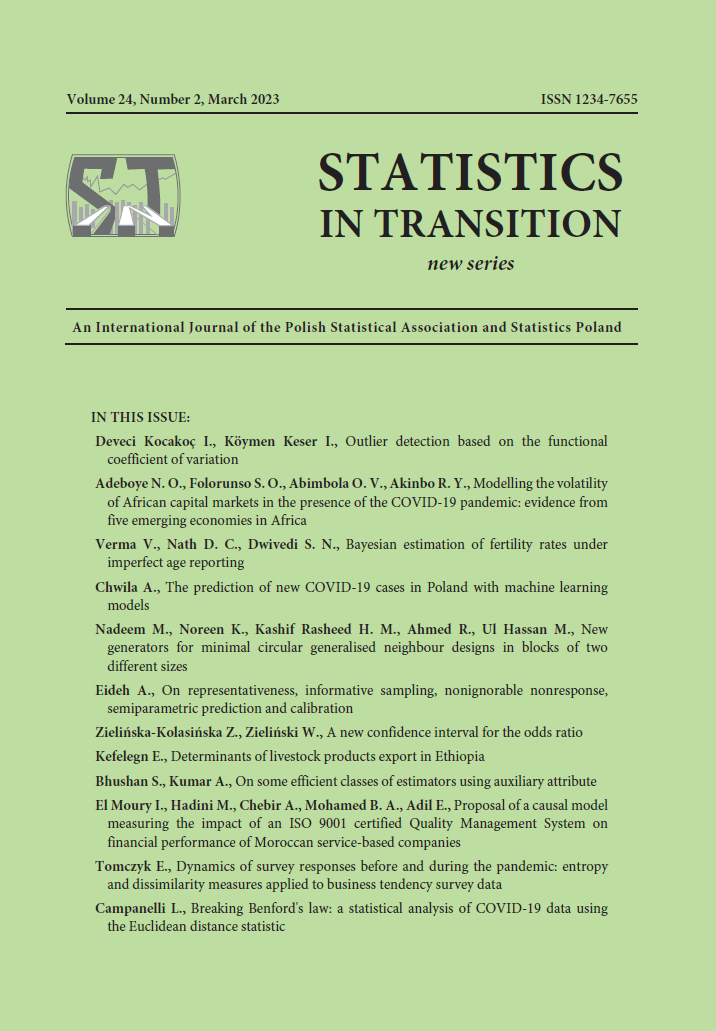ARTICLE
ABSTRACT
Ethiopia has one of the largest livestock populations in Africa. In 2016–2017, the share of live animals, leather, and meat in the total export of the country reached 9.6%.
This paper aims to identify the determinants of the export of Ethiopian livestock products by means of vector autoregressive and vector error correction models.
Multivariate time series is used to model the association between the products of the Ethiopian livestock export included in the study. Vector autoregressive and vector error correction models are used for modelling and inference.
The results indicated the existence of a long term correlation between the volume of live animals, meat and leather exports. The volume of meat export is significantly affected by a lag occurring in the export of live animals in the short-run. Therefore, 3.7% of the shortrun imbalance in the volume of leather export is adjusted each quarter.
It is suggested that the exporters of livestock products should properly utilise the Ethiopian livestock resources. On the other hand, the government should offer different forms of support to exporters, especially those focusing on exporting value-added products.
KEYWORDS
livestock export, VAR, VECM
REFERENCES
Aklilu, Y., (2002). An audit of the livestock marketing status in Kenya, Ethiopia and Sudan. 2 volumes. Prepared for AU-IBAR and PACE. Aklilu_market_vol2.pdf)
Berihu, A., (2014). Constraints of Livestock Development in Eastern Zone of Tigray; the case of “Ganta Afeshum Woreda”, Agricultural Science Research, 2(1), pp. 1–9.
Central Statistical Agency, (2015).Central Statistics Agency Annual Report 2015/16. Addis Ababa
Cho, G., Sheldon, I. M. and McCorriston, S., (2002). Exchange Rate Uncertainty and Agricultural Trade. American Journal of Agricultural Economics, 84 (4), pp. 931– 942.
Dickey, D. A., W. A. Fuller, (1979). Distribution of the estimators for autoregressive time series with a unit-root. Journal of the American Statistical Association, 74, pp. 427–431.
DeGrauwe, P., B. de Bellefoid, (1986). Long-run Exchange Rate Variability and International Trade. Cambridge, MA: MIT Press.
Gebergziaher, G., Solomon, A., and Afework, H., (2019). The impact of live animal export on meat and leather products export in Ethiopia, unpublished.
Granger, C. W. J., (1969). Investigating Causal Relations by Econometric Models and Cross Spectral Methods, Econometrica, 37, pp. 424–438.
Johansen, S., (1991). Estimation and Hypothesis Testing of Cointegration Vectors in Gaussian Vector Autoregressive Models. Econometrica, 59, pp. 1551–1580.
Lothian, J., Morry, M., (1978). A Set of Quality Control Statistics for the X-11-ARIMA Seasonal Adjustment Method, Research Paper, Statistics Canada.
MacKinnon, J. G., (1996). Numerical distribution functions for unit root and Cointegration tests. Journal of Applied Econometrics, 11, pp. 601–18.
Ministry of Agriculture and Rural Development, (2015). Major challenges and Achievements in Ethiopian Livestock production.
National Bank of Ethiopia, (2016). National Bank Annual Report 2016/17. Addis Ababa.
Phillips, P. C. B., Perron, P., (1988). Testing for a unit-root in time series regression. Biometrika, 75, pp. 335–346.
Reinsel, D. E., (1993). Vector Auto regressions and Reality. Journal of Business and Economic Statistics, 3, pp. 23–30.
Sintayehu, G., Samuel, A., Derek, B. and Ayele, S., (2010). Diagnostic study of live cattle and beef production and marketing: Constraints and opportunities for enhancing the system. ILRI & IFPRI, Addis Ababa, Ethiopia.
